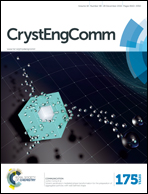Investigations on the microstructures of sea urchin spines via selective dissolution
Abstract
The sea urchin spines are composed of three-dimensionally bicontinuous porous magnesium-containing calcium carbonate embedded with a small amount of organic matrix. In this work, the selective dissolution process of transverse cross sections of sea urchin spines in aqueous solutions of Cu(NO3)2 was investigated to unravel their microstructures for the first time. A lot of concentric rings composed of microneedle arrays appeared on the transverse cross sections of sea urchin spines when they were kept in an aqueous solution of Cu(NO3)2 for a certain amount of time. Randomly arrayed microneedles instead of concentric rings were obtained on the annealed cross sections of sea urchin spines after a similar dissolution process. The unique phenomenon of selective dissolution might reveal a slightly heterogeneous distribution of occluded components such as the amorphous phase, Mg ions and biomolecules in the Mg-containing calcite mesocrystals of sea urchin spines, while the slight difference for the low amount of occluded components is hardly distinguished by using traditional elemental characterization techniques. These concentric rings were supposed to indicate the mineralization frontier of sea urchin spines.


 Please wait while we load your content...
Please wait while we load your content...